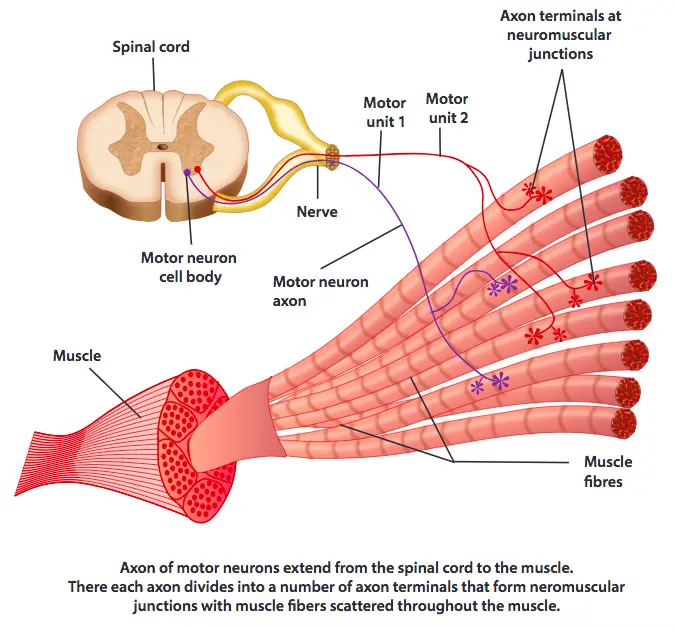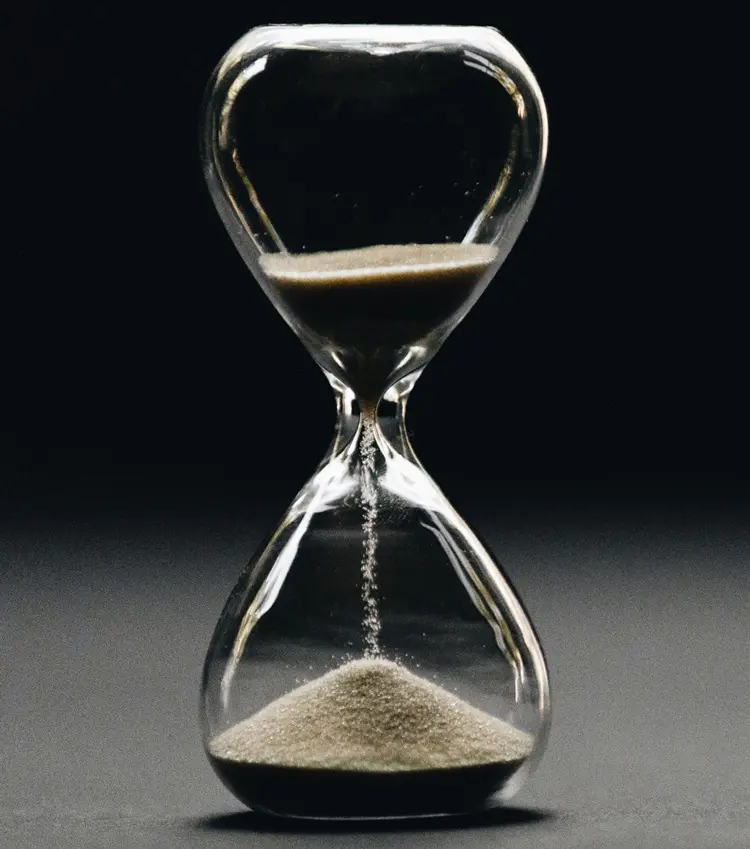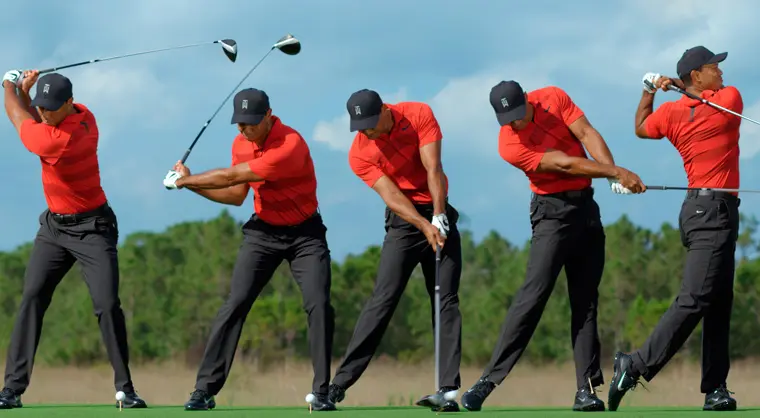Bigger muscles are usually stronger muscles. The amount of force a muscle can generate is linked to its cross-sectional size. However, sometimes, when it comes to strength, size isn’t everything.
Muscles are made of motor units. A motor unit is a group of muscle fibers and the nerve that innervates or controls those fibers. A muscle can have anything from just a few to several hundred motor units.
Motor units operate according to something called the all or nothing law. That means the muscle fibers that make up a motor unit either work at 100% of their contractile ability or they don’t work at all. A motor unit cannot work at 50% efficiency.

To produce differing amounts of force, your body innervates more or fewer motor units as required. It does this using your nervous system, which is basically a series of electrical conductors connecting your muscles to your brain via your spinal cord.
Unfortunately, your nervous system and the motor units that it controls are not 100% efficient, and your body can only innervate limited numbers of motor units at any one time. For the average person, that’s about 50% efficiency.
But, with the right kind of training, it’s possible to increase motor unit activation, so you can generate more force. This means you can get stronger without getting bigger. It also means that a smaller, well-trained person can be considerably stronger than a more muscular but less neurologically-coordinated person.
Level Up Your Fitness: Join our 💪 strong community in Fitness Volt Newsletter. Get daily inspiration, expert-backed workouts, nutrition tips, the latest in strength sports, and the support you need to reach your goals. Subscribe for free!
Regular strength training with heavy weights teaches your body to use more motor units at the same time. Yes, your muscles will get bigger, and that is the “engine” that lifts the weight. But your nervous system improves too, which makes that engine more efficient.
According to Russian kettlebell guru and all-round strength training expert Pavel Tsatsouline, one of the best ways to increase neural efficiency is to “grease the groove.”
What is Greasing The Groove?
According to Pavel, strength is a skill. There is no denying that muscle size plays a part but, he argues, if you want to be stronger, you need to strengthen not just your muscles but also the neurological pathway from your brain to the motor units.
Strengthening this pathway will teach you to use more of the available muscle fibers and generate more force. Like any skill, strength has to be practiced to be improved. And that’s where greasing the groove comes in.
With greasing the groove, or GtG for short, you do lots of reps of the exercise you want to improve without coming anywhere close to failure. The idea is to practice perfect form and avoid fatiguing your muscles or nervous system. By avoiding muscular failure, you can do lots of mini-workouts workouts over the course of a day, as it only takes minutes, and not days, to recover from each one.
Imagine you are learning to hit a golf ball. If you do so many swings that you get tired and your form deteriorates so much that you can’t even hit the ball, you aren’t going to improve much, if at all.
But, if you take a swing, rest a few minutes, and then swing again, fatigue is no longer an issue. Each practice shot should be close to perfect, and you won’t learn any bad habits. In short, you’ll make more progress by doing less. It’s not practice that makes perfect; it’s perfect practice that makes perfect.
In strength training, all of those perfect reps will teach your nervous system to be more efficient, so that you can recruit more motor units when required. You’ll get stronger despite not training to failure.
How to Grease The Groove to Build Strength
The concept of GtG training is simple – do lots of sets of your chosen movement and avoid training to failure, but what does that look like?
Here are three ways you can implement GtG training in your workouts.
On the hour, every hour
This method is the most regimented way to implement GtG training. Choose your exercise, such as pull-ups, and on the hour, every hour, do a few reps. How many? That depends on your current ability, but 30-50% of your current best is a good place to start. Just remember, at no point should you feel fatigued during your set, and each rep should be picture-perfect.

For example, if ten reps is your current maximum, do 3-5 reps every hour. Only do this during your WAKING hours; don’t feel the need to get up during the night to pump out a set of pull-ups!
Keep doing GtG training for 30 days and then retest to determine your new maximum. Adjust the number of reps per set based on your new record and continue for another month.
The external cue method
With this method, instead of doing a set of your chosen exercise every hour, you crank out a few reps every time you encounter a specific cue or trigger. For example, every time you walk under your doorway pull-up bar.
Level Up Your Fitness: Join our 💪 strong community in Fitness Volt Newsletter. Get daily inspiration, expert-backed workouts, nutrition tips, the latest in strength sports, and the support you need to reach your goals. Subscribe for free!
This method adds some variety to your GtG workouts but also means you could end up doing more reps one day and less the next. If that’s the case, do fewer reps per set on those days you encounter the trigger more often, and more reps if you encounter it less.
GtG supersets
A third way to use GtG is to do a quick set of your chosen movement between sets of regular strength training. For example, on leg day, why not do a set of 3-5 pull-ups between every lower body exercise in your program. Assuming you do five exercises for four sets each per workout, that’s 20 additional sets of pull-ups, none of which will have taken you anywhere near failure. And, you won’t have made your work out any longer or harder either.
Which Exercises are Best for GtG?
For an exercise to be suitable for GtG training, the main thing is that it needs to be accessible. You want to be able to pump out your reps with as little preparation and fuss as possible. Bodyweight exercises are ideal, as are fixed weight kettlebell and resistance band exercises.
Unless you actually work in a gym or can set a barbell up at home or in your office, back squats, deadlifts, bench presses, and power cleans, etc., are not very practical.
Some of the best GtG exercises are:
- Push-ups
- Pull-ups
- Dips
- Goblet squats
- Handstand push-ups
- Kettlebell swings
- Band pull-aparts
- Kettlebell cleans
- Kettlebell snatches
- Pistols

Greasing the groove will have a very noticeable effect on your performance of your chosen exercise. But, what if you want to increase your strength in a different movement, such as deadlifts, which are impractical for GtG training?
Simply choose a movement that uses the same muscles and joint actions, and you should find there is a crossover effect from the exercise you are doing to the one you want to improve.
For example, if you want to boost your bench press, GtG push-ups or dips should help. Similarly, if deadlifts are your passion, GtG kettlebell swings should work.
What are The Downsides of GtG Training?
Greasing the groove can definitely increase your strength. Not by making your muscles bigger, but by making them more efficient. You don’t even have to train that hard – all you need is lots of easy mini-workouts to get stronger.
But, as effective as GTG is, there are a few drawbacks too.
GtG is not always practical – if you work in an office, your colleagues may think you’re a bit odd if, on the hour and every hour, you drop down and pump out a set of push-ups. This may not even be possible if you are very busy. Still, that’s what you need to do to make GtG work.

Overuse injuries – doing lots of micro sets of a single exercise, even if you avoid failure, can still take its toll on your muscles, joints, and tendons. Reduce your chances of injury, aches, and pains by using perfect form at all times, keeping your reps slow and controlled, and stretching after each workout.
Could affect your other workouts – if you are cranking out 50 pull-ups a day with GtG, you may find that your regular back and biceps workout feels much harder than usual. Also, pushing it hard in your normal workout could have an impact on GtG. To avoid this, you may need to de-emphasize some of your other workouts so you can focus on GtG. Don’t worry, you won’t backslide and lose muscle size or strength. GtG should keep you on track.
GtG is not so useful for building muscle size – one of the primary triggers for muscle growth is training to failure, something you must avoid with GtG training. Subsequently, while GtG will make you stronger, it won’t make you bigger. But, that said, with your newly developed GtG strength, you’ll be able to lift heavier weights, and that will contribute to increased muscle size.
Wrapping up
If you want to get stronger, greasing the groove training can help. By reinforcing the neural pathways between your brain and your muscles, you can learn to recruit more motor units and muscle fibers, generating more force as a result. Your muscles won’t get any bigger. It’s just that you’ll be able to use the muscle fibers you’ve got more effectively.
To grease the groove, you will have to commit to lots of mini workouts almost every day of the week, but each one should last no more than a minute or so. And they’ll be easy too – no training to failure allowed!
Not convinced that GtG works, or that it’s for you? Drop down and do a max set of push-ups and make a note of how many you do. Then, for the next four weeks, do several sets per day of 30-50% of that number.
Resist the temptation to retest your push-up max until the end of the experiment. Let GtG work its magic.
Then, after four weeks, do another all-out push-up set. Don’t be surprised if you double your previous score, despite not having trained to failure for a month.
GtG really works, and you’ll be amazed at how effective it can be.










